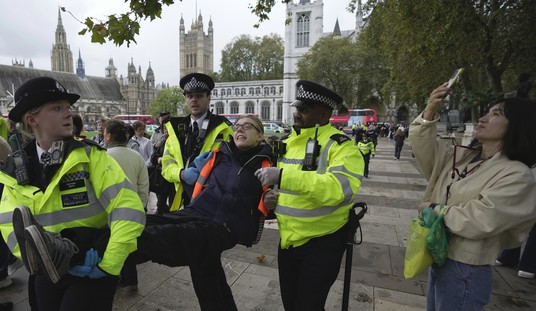On Friday, The New York Times ran a disgusting hit piece against Canadian psychologist and university professor Jordan Peterson. Reminiscent of the infamous interview with British journalist Cathy Newman from January, Times writer Nellie Bowles forced Peterson into her own preconceived idea of a sexist patriarchal bully and slandered him with every paragraph.
Bowles’s headline said it all: “Jordan Peterson, Custodian of the Patriarchy.” Many rushed to Peterson’s defense, but the psychologist himself took the attack in stride.
“The usual suspects on Twitter are having a conniption fit about [the story]. I actually quite liked [Nellie Bowles] (the writer),” Peterson quipped.
The usual suspects on Twitter are having a conniption fit about https://t.co/FZqoBNiSBc. I quite liked @nelliebowles (the writer).
— Dr Jordan B Peterson (@jordanbpeterson) May 18, 2018
While Peterson took the attack in stride and criticized some of his defenders as having a “conniption fit” about the story, in the interest of his eighth rule for life (“tell the truth — or, at least, don’t lie.”), I have decided to respond to Bowles’s smears on his behalf. My wife and I have read and thoroughly enjoyed his best-selling book, “12 Rules For Life: An Antidote to Chaos,” and consider the Times piece a violent misunderstanding of Peterson’s philosophy.
According to Bowles, Peterson defends the patriarchy to an absurd degree, attempting to reverse all “social progress,” blaming women for violent murderous “incels” (involuntary celibates), and pushing a government-enforced regime of involuntary marriage. The Times writer presented the psychologist as a malicious kook who decorates his house with violent images and believes flesh-and-blood witches and dragons are lurking around the corner.
In his book and elsewhere, Peterson follows Swiss psychiatrist Carl Jung in asserting the psychological importance of archetypes. The masculine and the feminine, like the yin and the yang, are powerful explanatory archetypes that help people make sense of their world. Peterson does indeed identify the masculine with order and consciousness and the feminine with chaos, and his bald statements about them seem shocking to modern ears.
This does not mean, however, that Peterson has identified femininity as the fundamental threat to modern society. The psychologist is far more nuanced than that. His chaos is not merely feminine, nor his order merely masculine. He opposes efforts to ensure equality of outcome, but he does not discourage women from pursuing positions of influence and power in society.
In her article, Bowles emphatically declared that “most of his ideas stem from a gnawing anxiety around gender.” She explained, “In Mr. Peterson’s world, order is masculine. Chaos is feminine. And if an overdose of femininity is our new poison, Mr. Peterson knows the cure. Hence his new book’s subtitle: ‘An Antidote to Chaos.'”
“The messages he delivers range from hoary self-help empowerment talk (clean up your room, stand up straight) to the more retrograde and political (a society run as a patriarchy makes sense and stems mostly from men’s competence; the notion of white privilege is a farce),” Bowles argued. “He is the stately looking, pedigreed voice for a group of culture warriors who are working diligently to undermine mainstream and liberal efforts to promote equality.”
Here lies the crux of the Times writer’s argument defending her smear against Peterson. Despite her article’s reporting style, little in Peterson’s actual quotes presents a pro-patriarchy view. In fact, “12 Rules For Life” emphasizes competence — not maleness or femaleness — as the standard by which power and influence should be attained.
The book rightly warns against the declining percentage of men graduating from college and university, and the agonizing fact that — on average — women seek a committed, long-term relationship with men who are dominant and that — with college increasingly vital to economic success — the pool of eligible men is vanishing.
Bowles surrounds her central core of an argument — that Peterson is pro-patriarchy — with anecdotes about his ideas, his home, and his mannerisms designed to embarrass the psychologist.
“Violent attacks are what happens when men do not have partners, Mr. Peterson says, and society needs to work to make sure those men are married,” she paraphrases, in a discussion about the incel terrorist Alek Minassian.
Bowles gives Peterson a word edgewise, but fails to explain his meaning. “‘He was angry at God because women were rejecting him,’ Mr. Peterson says of the Toronto killer. ‘The cure for that is enforced monogamy. That’s actually why monogamy emerges,'” the Times author reported.
When Peterson described Minassian as “angry at God,” he was using shorthand to say the incel terrorist was violating Rule 7, “Pursue what is meaningful (not what is expedient).” Peterson urges his readers to aim at the “betterment of Being,” and describes terrorists like Minassian as adherents of death, people who believe that Being is evil and wish to annihilate consciousness.
While Minassian may have been driven to Satanic impulses because women rejected him, Peterson does not blame women for his terror.
“Enforced monogamy,” as Ben Shapiro rightly pointed out, does not refer to a government policy requiring people to get married. Instead, it is an anthropological term for the moral norm upholding monogamy as the right context for sex. Marriage provides the most equal sexual outcomes, as the richest, most powerful, and most attractive men are restricted to one woman each.
Bowles also mocked Peterson for believing in witches:
But witches don’t exist, and they don’t live in swamps, I say.
“Yeah, they do. They do exist. They just don’t exist the way you think they exist. They certainly exist. You may say well dragons don’t exist. It’s, like, yes they do — the category predator and the category dragon are the same category. It absolutely exists. It’s a superordinate category. It exists absolutely more than anything else. In fact, it really exists. What exists is not obvious. You say, ‘Well, there’s no such thing as witches.’ Yeah, I know what you mean, but that isn’t what you think when you go see a movie about them. You can’t help but fall into these categories. There’s no escape from them.”
Again, Peterson was discussing Jungian archetypes. His description of witches in “12 Rules For Life” roots them in the behavior of overprotective mothers who doom their children to an incomplete psychological development. This ties into his eleventh rule, “Do not bother children when they are skateboarding.” He encourages readers to let kids get scratches and bruises, suggesting an overbearing hand does more harm than good.
Peterson is not warning against cackling women on broomsticks, but the archetype of the abusive mother figure. In fact, the psychologist has even suggested that he would not himself have chosen these archetypes, but they express deep truth, and discarding them — if it were possible — would to some degree entail eradicating humanity itself. As Bowles reported:
“You know you can say, ‘Well isn’t it unfortunate that chaos is represented by the feminine’ — well, it might be unfortunate, but it doesn’t matter because that is how it’s represented. It’s been represented like that forever. And there are reasons for it. You can’t change it. It’s not possible. This is underneath everything. If you change those basic categories, people wouldn’t be human anymore. They’d be something else. They’d be transhuman or something. We wouldn’t be able to talk to these new creatures.”
In her patronizing style, Bowles only reported this quote after imposing her own view on what Peterson meant: “Wherever he goes, he speaks in sermons about the inevitability of who we must be.” The Times writer assumed that Peterson is forcing people to accept his view, while according to the psychologist, he is accepting the traditional wisdom of archetypes and humanity the way it is.
Bowles had none of Peterson’s humility — she assumed the man was attempting a power grab through his words. Throughout “12 Rules For Life,” Peterson encourages self-knowledge, a humble acceptance that the reader himself or herself could be wrong, and that — in the words of Rule 6 — you should “set your house in perfect order before you criticize the world.”
Speaking of houses, the Times writer described Peterson’s house this way:
Mr. Peterson’s home is a carefully curated house of horror. He has filled it with a sprawl of art that covers the walls from floor to ceiling. Most of it is communist propaganda from the Soviet Union (execution scenes, soldiers looking noble) — a constant reminder, he says, of atrocities and oppression. He wants to feel their imprisonment, though he lives here on a quiet residential street in Toronto and is quite free.
“Marxism is resurgent,” Mr. Peterson says, looking ashen and stricken.
I say it seems unnecessarily stressful to live like this. He tells me life is stressful.
Whether or not this style creeped Bowles out, it is an accurate expression of Peterson’s philosophy. In his book, he urges readers to accept the stress of life and bring order to the chaos. He also warns against the government-enforced lies and propaganda of communism in his chapter on Rule 8, “Tell the truth — or, at least, don’t lie.” The death and tragedy of communism stemmed from the willingness of Soviet Russia, Maoist China, and Khmer Rouge Cambodia to lie in service of their ideology, without caring who died as a result.
Not content to misrepresent Peterson’s ideas, Bowles also attacked his physical appearance.
He does not smile. He has a weathered, gaunt face and big furrowed eyebrows. He has written about dogs being closest in behavior to humans, but there is something extremely feline about him. He always wears a suit. “I am a very serious person,” he often says.
Peterson may have odd mannerisms, and his philosophy is certainly eccentric, but physical attacks like this unnecessarily demonize the man. As Ben Shapiro noted, Peterson does indeed smile, and the Left would have a field day if a conservative writer called Ta-Nehisi Coates “extremely feline.”
In January, British journalist Cathy Newman “interviewed” Jordan Peterson, constantly interrupting him and twisting his ideas. Newman became infamous for saying, “So what you’re saying is…” and then grossly misrepresenting Peterson’s views.
While Newman allowed Peterson to correct her, Bowles had the final word in her New York Times article. At least Newman womansplained the psychologist to his face.









Join the conversation as a VIP Member